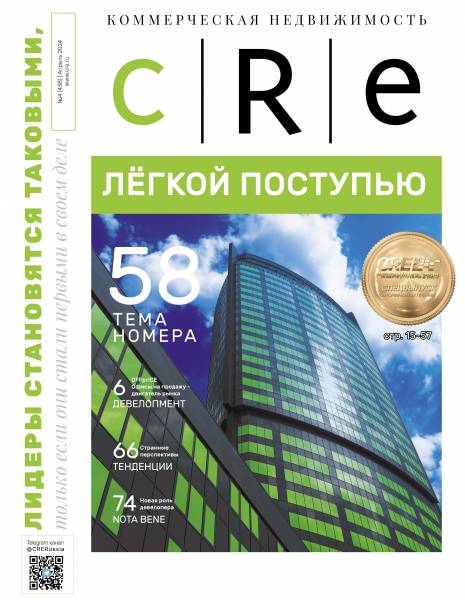The departure of commercial real estate developers from Moscow to the regions can hardly be called a new trend on the real estate market, although the reasons for this today are fundamentally different from the previous ones. At the beginning of the 2000s, when the professional commercial real estate market in Russia was only beginning to take shape, the developers tried to stake out land plots in Moscow and gain a foothold on this market, understanding that working in Moscow promised handsome bonuses. This is precisely when the first Western investors appeared in Moscow, scouring the market in search of quality properties and professional developers capable of meeting investor demand. Some of these companies were set up in Moscow, while others arrived from the regions, and sometimes were entirely foreign. However, even the mass-scale appearance of such developers didn’t create any problems for the Moscow market players: in those days there was demand for any commercial real estate project that offered even just a semblance of a concept and the promise of professional positioning. However, in the mid-2000s, and especially from 2006–2008 onward, the developers realized that Moscow alone wasn’t enough, and set out en masse to “stake” places and sites in the regions. Certain developers even succeeded in this, but the majority of plans were left on paper, notwithstanding the loud promises to build millions of square meters outside Moscow’s boundaries within the coming years.
According to the developers, the blame for this lies with the financial crisis, which significantly diminished the market players’ wealth. Yet independent market players hold to a different opinion: the financial models of all the developers“project builders” were simply very shaky, and, figuratively speaking, skyscrapers were being built upon very weak financial foundations. “Many of the developers who were promising to take all the Russian regions and fill them with their own projects had at most two, and usually not even one fully completed building,” says one of the Moscow consultants. “What kind of foundation can be discussed in this situation? And of course, their beautiful paper constructions immediately crumbled; all it took was the smallest breeze on the market.” In their turn, two developers mentioned in private conversations that in fact the consultants continually exhorted the market players to enter new markets, acquire ever newer properties and take out new loans. “They drew up pretty models and argued that the project would be successful within half a year after launch, when in fact the market had no need for such projects,” one of them demurs. According to him, the crisis served as an indicator of the success of companies’ business and the effectiveness of their projects: those who built projects based on a strong foundation are still in chocolate, while the others either left the market or went broke.
Yet as soon as total calm returned to the real estate market, the hapless billionaires again raised their heads and again became interested with the regional commercial real estate markets. What will be the fate of the developers’ second siege of the regions?
Recognized need
Since mid-2011, the topic of the regions has come up increasingly often in conversations with developers and consultants. Supposedly, an untilled field exists precisely in those areas where those ambitious developers who survived the crisis can now further develop. At the same time, however, from 2008 until the end of 2010, neither developers nor tenants even wanted to hear about the regions. And now – everyone at once started talking about the attractiveness of real estate markets outside of Moscow. And whereas consultants largely prefer to speak, the developers and tenants have started reinforcing words with deeds, with the opening of new retail and warehouse centers and stores outside of Moscow.
However, the developers today are being led to the regions not by ambitions, but by a recognized necessity. Today there are several reasons for expansion into the regions. First, after Moscow Mayor Yuri Luzhkov left his post, there has been a material change in the rules of the game on the market, and largescale new construction has essentially fallen under prohibition. In particular, in 2011 alone in Moscow more than 300 investment contracts were rescinded, which called for the construction of approximately 8 mln sq. m of various real estate, including commercial properties. Furthermore, according to the developers, the new rules have also clearly affected project profitability, since many developers were allowed to continue building, although the amount of space permitted was substantially reduced. “For those developers who purchased sites at the stratospheric pre-crisis prices, this proved a painful blow, because the economics of such projects didn’t withstand the new rules of the game,” says one of the market players. According to another developer, it has become far more difficult in Moscow to get approval for new projects, while the cost of such approvals, including informal ones, has rocketed upward. “In conditions of the stated war, for the approval of even a small project the major developers are being asked to pay such sums that it’s easier to abandon implementation than to continue,” he says. Of course, following the emergence of such rules the market players have been forced to seek alternative opportunities for deploying their capital. And these have been provided precisely by markets in the Moscow region and beyond, according to Colliers International.
The second reason mentioned by all the experts who responded to the poll is that the Moscow market following the crisis became much more contested and opportunities for implementing plainly inferior projects have reduced to nothing. “Nowadays such projects cannot be sold to banks, tenants or investors, because everyone has started approaching the selection of properties in which to invest far more thoughtfully,” says one of CRE’s interlocutors. Following the avalanche of defaults in 2008, this is hardly surprising. Furthermore, despite the resurgent economy, demand for commercial real estate has returned to the market in limited quantities: investors only want to work with quality projects guaranteed to return all costs and turn a profit. Meanwhile, no one wants to do anything with projects offering dubious prospects. So right now, despite the deficit of space, competition on the market continues among projects for quality, solvent tenants – a group that has also contracted. This is a further reason why developers are exploring regional markets, where demand is currently much less conservative. “Tenants in Moscow are no longer reacting to billboards reading “For rent” or “We’re open” and require proof that the project will be successful. And if they don’t get it, they can always find alternative places to set up their offices or stores,” says Yevgeny Danilov, Partner at NA Group. “So far this isn’t happening in the regions, and tenants are less strict when it comes to accepting projects, especially in those cities where professional retail and office centers are absent as a class.”
And yet, despite this, whether the developers will be able to repeat their entrance to the regional markets and achieve more success than before is a major question.
Small steps
Lately, however, Russian commercial real estate developers have been more carefully minded when moving into the regions. According to Yevgeny Danilov, those developers who are currently unfreezing their “paper” properties in the regions are looking very attentively at the surrounding infrastructure and selecting only those projects that are located in the least contested environment capable of providing stable demand on the part of tenants. “In terms of regional expansion, the retail real estate developers are the most active. They are currently exploring not only the million-plus cities, but also the seemingly smaller cities with a population below 500,000. A good example is Surgut, where the project Aura is being implemented. Purchasing power in the city is extremely high, while the provision of retail space totals only 82 sq. m per 1000 residents,” says Yulia Nikulicheva, deputy director of the strategic consulting department at Jones Lang LaSalle. Meanwhile, office developers in the regions are all but idle, except for those projects being implemented for a specific client. Warehouse complexes are mostly being built in multi-territory logistical centers, where logistical flows are serviced for several cities.
But even the most active operators – the retail center developers – are highly selective when it comes to choosing cities for expansion. For example, projects today practically aren’t being built in cities saturated with retail centers, while they are actively exploring regions where such properties are nearly absent. According to the majority of specialists, the new conquistadores of the development business will place their bets precisely on the cities with populations of up to 500,000. “At the same time, developers are no longer going to certain major cities, or they’re proceeding with caution due to their active exploration in previous years. In particular, new retail properties are not being implemented in Kazan, while developers view Novosibirsk with trepidation, frequently preferring the neighboring cities of Kemerevo and Barnaul. Right now there’s active demand in Samara and Perm, which previously were developed by local companies and were practically closed for “outside” companies,” says Yulia Nikulcheva.
Incidentally, this strategy already proved its viability in the past: it was approximately in this way that Tashir Group began the construction of its chain, which currently occupies one of the leading positions in the Russian retail property market. The company delivered its first projects in the cities with slack competition, and then built demand for this format of properties. And only then the company began exploring bigger cities. Today, REGIONS Group, together with Finstar Properties, is making a bid for regional expansion through the delivery of projects in smaller cities: the partners are planning to build the first 40,000-sqm project in Syktyvkar. Also interested in smaller cities is Torgovy Kvartal and several other developers. “Small cities are currently less interesting for the major federal operators,” says Dmitry Volkov, head of the research division at Praedium International. “In cities with populations below 300,000, most of the activity is among the local players. Furthermore, it should be noted that for the small cities, the lack of interest on the part of the federal developers, from an urban planning standpoint, is not a disadvantage. One has to realize that the influence of one major property (for example, a retail center) in small cities is far more palpable than in mid-sized and large cities. Yet the experience of integrating commercial real estate properties into the existing urban environment (in terms of architecture as well as lifestyle) is currently insufficient among our companies.”
On the whole, regional expansion is currently underway among many major developers: TPC Real Estate, RosEvroDevelopment, Renaissance Development and others. However, not all market players are viewing the regions with such zeal. For example, Tashir Group is seeking to concentrate on the Moscow market, says Vitaly Efimkin, vice president of the development company, explaining that there is still high demand in Moscow for retail centers, whereas it is much lower in the regions. However, other experts believe that the chains are becoming cramped in Moscow, so they are also seeking opportunities for expansion in the regions. “Major retail operators’ interest in small cities depends upon a multitude of factors. Above all, this is the social-economic conditions of the population, as well as the level of competition. Another important factor is the existence of the appropriate quality supply of retail space,” explains Konstantin Kovalev, managing partner at Blackwood.
Market experts anticipate that in the future a full-fledged infrastructure will begin to emerge in the regions, suitable for the development of commercial real estate, which will be followed by warehouses, because demand for retail creates the need for warehouses. More complicated is the question of office real estate, because demand for offices in the regions is low and fully met by existing supply. “In the near-term we don’t see any prospects for the development of the office market in the regions: rental rates there are so low that there won’t be any projects implemented over the next three years,” Yulia Nikulicheva believes. Yet even the builders of retail centers and warehouses, whom, apparently, all the analysts give the green light for regional expansion, will do this very cautiously and hesitantly, so as not to step on the same rake as they did in 2008, Konstantin Kovalev believes. The crisis taught at least this much to federal developers in Russia.













